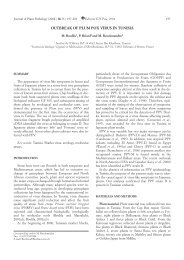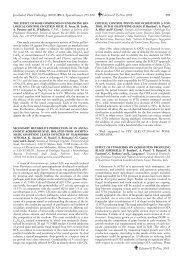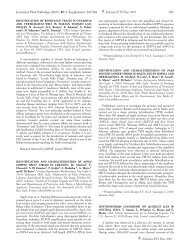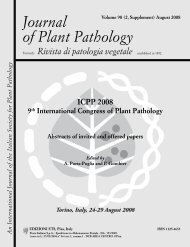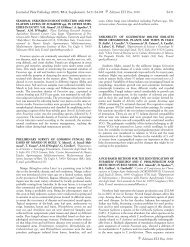CONTROL OF XANTHOMONAS CAMPESTRIS pv ... - Sipav.org
CONTROL OF XANTHOMONAS CAMPESTRIS pv ... - Sipav.org
CONTROL OF XANTHOMONAS CAMPESTRIS pv ... - Sipav.org
- No tags were found...
Create successful ePaper yourself
Turn your PDF publications into a flip-book with our unique Google optimized e-Paper software.
362 Control of X. campestris <strong>pv</strong>. vignicola in cowpea Journal of Plant Pathology (2007), 89 (3), 361-367fection and for an efficient control of bacterial blight inseedlings. The efficacy of PCC and H 2O 2in sterilizationof cowpea seeds was compared with that of sodiumhypochlorite (NaOCl), a known seed sterilizer.MATERIALS AND METHODSExperimental design. Unless otherwise stated, eachexperiment was repeated three times and each treatmentwithin an experiment was performed in threereplicates. For chemical seed treatment experiments,sets of 400 cowpea seeds were used per tested chemicalconcentration and per replicate, while sets of 40seeds/seedlings were used for greenhouse pathogenicitytests. Data were expressed as mean values (±SE) of atleast three independent experiments, where applicable.P values were determined by Student’s t-test analysis. Avalue of P < 0.05 was considered statistically significantfor the mean differences.Inoculum preparation and in vitro antibacterial testsof PCC and H 2O 2. X. campestris <strong>pv</strong>. vignicola, was isolatedfrom cowpea seeds (cv. Ife brown) using the agar isolationprocedure according to Lelliot and Stead (1987),generously provided by Dr. N. Torimiro (Department ofMicrobiology, Obafemi Awolowo University, Ile-Ife).The bacterial strain was maintained in glycerol at -80 o Cand periodically sub-cultured to preserve viability. Forthe inoculum preparation, a single bacterial colony wastransferred to LB nutrient broth and incubatedovernight on a rotary shaker (250 rpm, 25±1 o C). Thebacterial culture was then centrifuged (6,500 g for 15min at 4 o C) and the pellet resuspended in the inoculumsuspension buffer (ISB), i.e. 0.1 mM sodium phosphatebuffer pH 7.0 containing 0.7% NaCl. The bacterial ISBwas adjusted spectrophotometrically at 600 nm to 1×10 5cfu/ml and used as source of inoculum. Unless otherwisestated, cowpea seedlings were spray-inoculated using anatomizer sprayer in greenhouse experiments.To test the antibacterial effects of PCC and H 2O 2,300 ml of LB medium supplemented with different concentrationsof PCC (Sigma, Steinheim, Germany) andH 2O 2(Sigma, Steinheim, Germany) in a one-litre conicalflask, were inoculated with the bacterial inoculumand incubated at 25±1 o C under shaking conditions (250rpm). Samples (0.1 ml) were removed every hour with amulti channel pipette (to obtain replicates) to examinebacterial cell growth at OD 600 nm. The measuringtime was kept to the strict minimum to avoid alteringthe end concentration of the bacteria in the culturingmedia at each measurement.Effect of chemical treatment on seed germination.This experiment was set to determine the longest durationand the highest concentration of PCC and H 2O 2inwhich cowpea seeds could be soaked without phytotoxiceffects. Concentrations of PCC and H 2O 2rangingfrom 0 to 5 mM were prepared and used to wet sterilefilter papers in sterile containers. H 2O 2concentrationswere spectrophotometrically measured as quickly aspossible, and the solution was kept in the dark to avoidlight-induced degradation.Seeds were then rolled in the filter papers moistenedwith the appropriate concentration of chemicals, werekept for different soaking periods at room temperaturethen rinsed in water to remove excess of chemicals andplated out on filter papers moistened with sterile distilledwater for a germination test. Seed were germinatedin a growth chamber at 23±2 o C and at light intensityof 150-200 µE m -2 S -1 with a day/night cycle of 14/10 h.The effect of the chemical treatment on seed germinationwas determined 7 days after seed incubation. In thecontrol samples, seeds were soaked in sterile distilledwater only.To test the effect of PCC and H 2O 2as seed sterilizers,seeds were soaked for 30 min on a shaker at 200 rpm, in1.5% NaOCl, 1 mM PCC, 1 mM H 2O 2or 1 mMPCC/H 2O 2respectively, then rinsed in six changes ofsterile distilled water. Seeds were then plated on wateragar and incubated in a growth chamber [23±2 o C and atlight intensity of 150-200 µE m -2 S -1 with a day/night cycleof 14h/10 h]. Individual seeds from which bacterialcolonies grew were considered as infected.Effect of seed treatment on bacterial blight in thegreenhouse. To assess the protective effect of the chemicals,and to determine whether the seed treatmentwould lead to a reduced disease incidence duringseedling development, groups of 40 seeds treated with 1mM PCC, 1 mM H 2O 2or a combination of 1 mM PCCand 1 mM H 2O 2as described above, were planted inplastic pots (15 cm in diameter, 15 cm deep) containingsteam-sterilised soil [field soil/compost in the ratio of2:1 and 5 g “plantosan” long-term fertilizer (20:10:15)]and kept in the greenhouse (23±2 o C, light intensity of150-200 µE m -2 S -1 with a day/night cycle of 14/10 hand 50±2% humidity) for germination and seedling development.For control, another group of 40 seed sampleswere treated with sterile water and allowed to growunder the same conditions. Fourteen days after seedlingemergence, the plants were sprayed with the pathogenand incubated in a moist chamber for 24 h before beingtransferred to the greenhouse. Seven days after inoculationi.e. 21 days after seedling emergence, disease assessmentwas done by scoring for disease severity using anarbitrary scale from 1 to 6, where 1= no symptom; 2 =visible necrotic lesions with chlorotic haloes on < 10%of the leaf area; 3 = symptoms on 10-30% of the leafarea; 4 = symptoms on 31-50% of the the leaf area; 5 =symptoms on 51-75% of the leaf area; 6 = symptoms on> 75% of the leaf area (Okechukwu and Ekpo, 2004).



